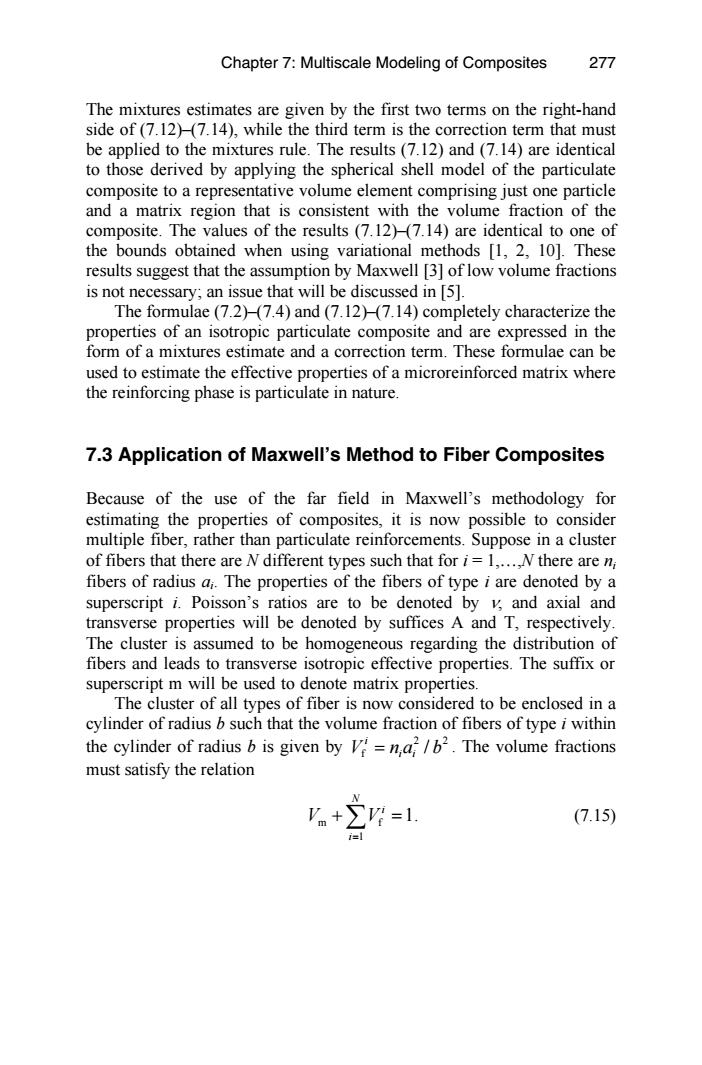正在加载图片...

Chapter 7:Multiscale Modeling of Composites 277 The mixtures estimates are given by the first two terms on the right-hand side of (7.12)(7.14),while the third term is the correction term that must be applied to the mixtures rule.The results(7.12)and (7.14)are identical to those derived by applying the spherical shell model of the particulate composite to a representative volume element comprising just one particle and a matrix region that is consistent with the volume fraction of the composite.The values of the results (7.12)(7.14)are identical to one of the bounds obtained when using variational methods [1,2,10].These results suggest that the assumption by Maxwell [3]of low volume fractions is not necessary;an issue that will be discussed in [5]. The formulae(7.2)-(7.4)and (7.12)(7.14)completely characterize the properties of an isotropic particulate composite and are expressed in the form of a mixtures estimate and a correction term.These formulae can be used to estimate the effective properties of a microreinforced matrix where the reinforcing phase is particulate in nature. 7.3 Application of Maxwell's Method to Fiber Composites Because of the use of the far field in Maxwell's methodology for estimating the properties of composites,it is now possible to consider multiple fiber,rather than particulate reinforcements.Suppose in a cluster of fibers that there are N different types such that for i=1,...,N there are n fibers of radius a.The properties of the fibers of type i are denoted by a superscript i.Poisson's ratios are to be denoted by v and axial and transverse properties will be denoted by suffices A and T,respectively. The cluster is assumed to be homogeneous regarding the distribution of fibers and leads to transverse isotropic effective properties.The suffix or superscript m will be used to denote matrix properties. The cluster of all types of fiber is now considered to be enclosed in a cylinder of radius b such that the volume fraction of fibers of type i within the cylinder of radius b is given by V=n,a2/b2.The volume fractions must satisfy the relation (7.15)The mixtures estimates are given by the first two terms on the right-hand side of (7.12)–(7.14), while the third term is the correction term that must be applied to the mixtures rule. The results (7.12) and (7.14) are identical to those derived by applying the spherical shell model of the particulate composite to a representative volume element comprising just one particle composite. The values of the results (7.12)–(7.14) are identical to one of the bounds obtained when using variational methods [1, 2, 10]. These The formulae (7.2)–(7.4) and (7.12)–(7.14) completely characterize the properties of an isotropic particulate composite and are expressed in the form of a mixtures estimate and a correction term. These formulae can be used to estimate the effective properties of a microreinforced matrix where the reinforcing phase is particulate in nature. 7.3 Application of Maxwell’s Method to Fiber Composites Because of the use of the far field in Maxwell’s methodology for estimating the properties of composites, it is now possible to consider multiple fiber, rather than particulate reinforcements. Suppose in a cluster i fibers of radius ai. The properties of the fibers of type i are denoted by a superscript i. Poisson’s ratios are to be denoted by ν, and axial and transverse properties will be denoted by suffices A and T, respectively. The cluster is assumed to be homogeneous regarding the distribution of The cluster of all types of fiber is now considered to be enclosed in a cylinder of radius b such that the volume fraction of fibers of type i within the cylinder of radius b is given by 2 2 f / i V na b = i i . The volume fractions must satisfy the relation m f 1 1. N i i V V= +∑ = (7.15) Chapter 7: Multiscale Modeling of Composites results suggest that the assumption by Maxwell [3] of low volume fractions and a matrix region that is consistent with the volume fraction of the is not necessary; an issue that will be discussed in [5]. fibers and leads to transverse isotropic effective properties. The suffix or of fibers that there are N different types such that for i = 1,…,N there are n superscript m will be used to denote matrix properties. 277